Posters
Our Praxis project teams each produce an academic poster at the end of their project. We’ve included some examples here:
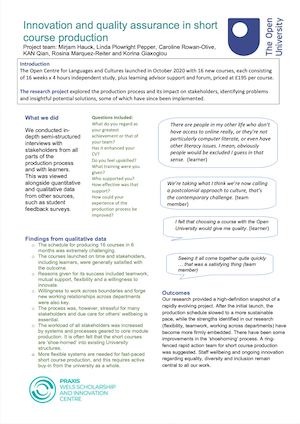
Innovation and quality assurance in short course production
Innovation and quality assurance in short course production
Mirjam Hauck, Linda Plowright Pepper, Caroline Rowan-Olive, KAN Qian, Rosina Marquez-Reiter and Korina Giaxoglou
Introduction The Open Centre for Languages and Cultures launched in October 2020 with 16 new courses, each consisting of 16 weeks x 4 hours independent study, plus learning advisor support and forum, priced at £195 per course.
The research project explored the production process and its impact on stakeholders, identifying problems and insightful potential solutions, some of which have since been implemented.
What we did We conducted indepth semi-structured interviews with stakeholders from all parts of the production process and with learners. This was viewed alongside quantitative and qualitative data from other sources, such as student feedback surveys.
Questions included: What do you regard as your greatest achievement or that of your team? Has it enhanced your CV? Do you feel upskilled? What training were you given? Who supported you? How effective was that support? How could your experience of the production process be improved?
Findings from qualitative data:
o The schedule for producing 16 courses in 6 months was extremely challenging.
o The courses launched on time and stakeholders, including learners, were generally satisfied with the outcome.
o Reasons given for its success included teamwork, mutual support, flexibility and a willingness to innovate.
o Willingness to work across boundaries and forge new working relationships across departments were also key. o The process was, however, stressful for many stakeholders and due care for others’ wellbeing is essential.
o The workload of all stakeholders was increased by systems and processes geared to core module production. It is often felt that the short courses are ‘shoe-horned’ into existing University structures.
o More flexible systems are needed for fast-paced short course production, and this requires active buy-in from the university as a whole.
Outcomes: Our research provided a high-definition snapshot of a rapidly evolving project. After the initial launch, the production schedule slowed to a more sustainable pace, while the strengths identified in our research (flexibility, teamwork, working across departments) have become more firmly embedded. There have been some improvements in the ‘shoehorning’ process. A ringfenced rapid action team for short course production was suggested. Staff wellbeing and ongoing innovation regarding equality, diversity and inclusion remain central to all our work.
“There are people in my other life who don’t have access to online really, or they’re not particularly computer literate, or even have other literacy issues. I mean, obviously people would be excluded I guess in that sense.” (learner)
“We’re taking what I think we’re now calling a postcolonial approach to culture, that’s the contemporary challenge.” (team member)
“I felt that choosing a course with the Open University would give me quality.” (learner)
“Seeing it all come together quite quickly … that was a satisfying thing.” (team member)
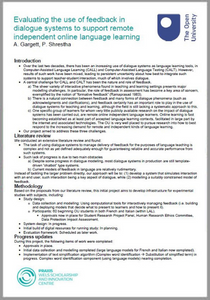
Evaluating the use of feedback in dialogue systems to support remote independent online language learning
Evaluating the use of feedback in dialogue systems to support remote independent online language learning
A. Gargett, P. Shrestha
Introduction
-
Over the last two decades, there has been an increasing use of dialogue systems as language learning tools, in Computer-Assisted Language Learning (CALL) and Computer-Assisted Language Testing (CALT). However, results of such work have been mixed, leading to persistent uncertainty about how best to integrate such systems to support teacher-student interaction, much of which involves dialogue.
-
A central challenge for CALL and CALT has been the nature and role of feedback.
-
The sheer variety of interactive phenomena found in teaching and learning settings presents major modelling challenges. In particular, the role of feedback in assessment has become a key area of concern, exemplified by the notion of “formative feedback” (Ramaprasad 1983).
-
There is a natural connection between feedback and many forms of dialogue phenomena (such as acknowledgments and clarifications), and feedback certainly has an important role to play in the use of dialogue systems for teaching and learning, although the field is still lacking a systematic approach to this.
-
One specific group of learners for whom very little publicly available research on the impact of dialogue systems has been carried out, are remote online independent language learners. Online learning is fast becoming established as at least part of accepted language learning contexts, facilitated in large part by the internet and associated technologies. The OU is very well placed to pursue research into how to best respond to the increasing demand for remote and independent kinds of language learning.
-
-
Our project aimed to address these three challenges.
Literature review
We conducted an extensive literature review and found:
-
The task of using dialogue systems to manage delivery of feedback for the purposes of language teaching is complex and not as yet defined adequately enough for guaranteeing reliable and accurate performance from such systems.
-
Such lack of progress is due to two main obstacles
-
Despite some progress in dialogue modelling, most dialogue systems in production are still template-driven “chatbot” type systems.
-
Current models of feedback in language are relatively rudimentary.
-
Instead of tackling the larger problem directly, our approach will be to: (1) develop a system that simulates interaction with an end user, such interaction being a key aspect of dialogue, while (2) modelling a suitably constrained model of feedback.
Methodology
Based on the proposals from our literature review, this initial project aims to develop infrastructure for experimental studies with subjects, including:
-
Study design:
-
Data collection and modelling: Using computational tools for interactively managing feedback (i.e. building and deploying models that decide what to present to learners and how to present it).
-
Participants: 60 beginning OU students in both French and Italian (within LAL).
-
Approvals now in place for Student Research Project Panel, Human Research Ethics Committee, Data Protection Impact Assessment.
-
-
-
System design: In progress.
-
Initial build of digital resources for running study: In planning.
-
Evaluation framework: Scheduled as later work.
Progress updates
During this project, the following items of work were completed:
-
Approvals in place.
-
Initial data collection and modelling completed (large language models for French and Italian now completed).
-
Implementation of text simplification algorithm (Complex word identification ? Substitution of simplified term) in progress. Complex word identification component (using language models) nearing completion.
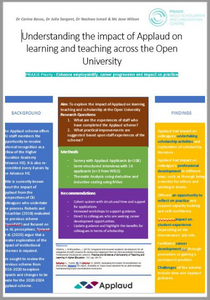
Understanding the impact of Applaud on learning and teaching across the Open University
Understanding the impact of Applaud on learning and teaching across the Open University
Carina Bossu – Senior Lecturer WELS, IET
PRAXIS priorities - Enhance employability, career progression and impact on practice
Background
The Applaud scheme offers OU staff members the opportunity to receive external recognition as a fellow of the Higher Education Academy (Advance HE). It is also re-accredited every 4 years by the Advance HE.
Little is currently known about the impact of Applaud from the perspectives of OU colleagues who undertake the process. Roberts and McLachlan (2018) evaluated the previous scheme (OpenPAD) and focused on the AL perceptions. Spowart et al. (2020) argue that a greater exploration of the impact of institutional schemes is required.
We sought to review the previous scheme from 2016-2020 to explore impacts and changes to be made for the 2020-2024 Applaud scheme.
Aim
To explore the impact of Applaud on learning, teaching and scholarship at the Open University
Research Questions
- What are the experiences of staff who have completed the Applaud scheme?
- What practical improvements are suggested based upon staff experiences of the scheme?
Methods
- Survey with Applaud Applicants (n=108)
- Semi-structured interviews with 14 applicants (n=3 from WELS)
- Thematic Analysis using deductive and inductive coding using NVivo
Recommendation
- Cohort system with structured time and support for applications
- Increased workshops to support guidance.
- Direct to colleagues who are seeking career development opportunities
- Update guidance and highlight the benefits for colleagues in terms of scholarship.
Findings
- Applaud had impact on colleagues undertaking scholarship activities and exploration of scholarship literature.
- Applaud had impact on colleague’s professional development in different ways, such as through being a mentor for others and working in teams.
- Offered an opportunity to reflect on practice and support capacity building and self-confidence.
- Applaud’s impact on student experience depending on the interviewees’ job role.
- Facilitated career development i.e. through promotion or gaining a permanent position.
- Challenges of the scheme include time and Applaud guidance.
References
Roberts, J. & McLachlan, J. (2018). Integrated and situated academic development for all categories of staff: Lessons for constructive alignment from an HEA-accredited Continuing Professional Development scheme. Practice and Evidence of Scholarship of Teaching and Learning in Higher Education, 13(1) pp. 49–73.
Spowart, L., Turner, R,, & Dismore, H. (2020). Assessing the impact of accreditation on institutions. Advance HE report. Available at: https://www.advance-he.ac.uk/knowledge-hub/assessing-impact-accreditation-institutions
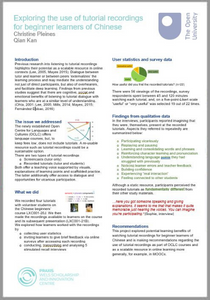
Exploring the use of tutorial recordings for beginner learners of Chinese
Exploring the use of tutorial recordings for beginner learners of Chinese
Christine Pleines and Qian Kan
Introduction
Previous research into listening to tutorial recordings highlights their potential as a scalable resource in online contexts (Lee, 2005, Mayes 2015). Dialogue between tutor and learner or between peers ‘externalizes’ the learning process and may mediate the understanding not just of direct participants, but also of overhearers, and facilitate deep learning. Findings from previous studies suggest that there are cognitive, social and emotional benefits of listening to tutorial dialogue with learners who are at a similar level of understanding. (Ohta, 2001; Lee, 2005; Mills, 2014; Mayes, 2015; Fernández Dobao, 2016)
The issue we addressed
The newly established Open Centre for Languages and Cultures (OCLC) offers language courses, but, to keep fees low, does not include tutorials. A re-usable resource such as tutorial recordings could be a sustainable option.
There are two types of tutorial recordings;
- Screencasts (tutor only)
- Recorded tutorials (tutor and students)
Both offer a teaching voice supported by visuals, explanations of learning points and scaffolded practice. The latter additionally offer access to dialogue and opportunities for vicarious participation.
What we did
We recorded four tutorials with volunteer students on the Chinese beginners’ course LXC001-20J. We then made the recordings available to learners on the course and its subsequent presentation (LXC001-21B).
We explored how learners worked with the recordings by
- collecting user statistics
- inviting learners to give brief feedback via online surveys after accessing each recording
- conducting, transcribing and analysing 5 stimulated recall interviews
User statistics and survey data
There were 56 viewings of the recordings, survey respondents spent between 45 and 120 minutes watching each tutorial, and, on a five-point-Likert scale “useful” or “very useful” was selected 19 out of 22 times.
Findings from qualitative data
In the interviews, participants reported imagining that they were, themselves, present at the recorded tutorials. Aspects they referred to repeatedly are summarized below:
- Participating vicariously
- Replaying and pausing
- Learning and consolidating words and phrases
- Reinforcing character learning and pronunciation
- Understanding language points they had struggled with previously
- Noticing learner errors and teacher feedback
- Building confidence
- Experiencing “real interaction”
- Feeling connected to other students
Although a static resource, participants perceived the recorded tutorials as fundamentally different from their other study materials.
…here you got someone speaking and giving explanations, it seems to me that that makes it quite memorable just hearing the voices. You can imagine you're participating.” Sophie, interview
Recommendations
This project explored potential learning benefits of watching tutorial recordings for beginner learners of Chinese and is making recommendations regarding the use of tutorial recordings as part of OCLC courses and as a scalable resource in online learning more generally, for example, in MOOCs.
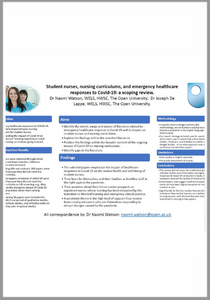
Student nurses, nursing curriculums, and emergency healthcare responses to Covid-19
Student nurses, nursing curriculums, and emergency healthcare responses to Covid-19: a scoping review
Dr Naomi Watson, WELS, HWSC, The Open University
Dr Joseph De Lappe, WELS, HWSC, The Open University
Introduction
- Emergency healthcare responses to COVID-19 substantially impacted upon nursing curriculums for student nurses.
- Understanding the impact of Covid-19 on student nurses’ learning experiences could inform nursing curriculums going forward.
Data Extraction Results
- 356 papers were retrieved through initial database and hand searches; 260 once duplicates were removed.
- After sifting title and abstract, 180 papers were removed because they did not meet the inclusion criteria.
- 80 full text papers remained, of which 64 were excluded because they did not meet the inclusion criteria on full screening, e.g., they focused on the disruptive impact of Covid-19 on clinical practice rather than nursing curriculums.
- The remaining 16 papers were included for review which comprised of qualitative studies, mixed-methods studies, and reflective editorial informed by prior empirical studies.
Aims
- Identify the extent, range and nature of literature related to emergency healthcare response to Covid-19 and its impact on student nurses and nursing curriculums.
- Explore the findings within the searched literature.
- Position the findings within the broader content of the ongoing impact of Covid-19 on nursing curriculums.
- Identify gaps in the literature.
Findings
- The selected papers emphasise the impact of healthcare responses to Covid-19 on the mental health and well-being of student nurses.
- Their fears for themselves and their families as frontline staff in the fight against the pandemic.
- Their anxieties about their future career prospects as registered nurses whose training has been impacted by the transition to blended learning and emergency clinical practice.
- A persistent theme is the high level of support they receive from nursing educators who are themselves responding to abrupt changes caused by the pandemic.
Methodology
- Using the Johanna Briggs Institute (JBI) methodology, we conducted a scoping review of literature published in the English language from 2019 to 2021.
- Our search strategy included specific search terms which were used to search five online databases: CINAHL, ProQuest, and PubMed and OVID, and Google Scholar. A narrative approach was used to synthesise the identified papers.
Limitations
- Only studies in English searched.
- No quality assessment of studies.
Conclusions
- The review did not assess for quality but, given the selected studies were themselves emergency responses to Covid-19 conducted in haste, the reviewers deemed the quality of evidence to be low.
- Nonetheless, they suggest healthcare responses to Covid-19 have been highly disruptive for many student nurses.
- Significantly for the OU, studies focused almost entirely on face-to-face learners on traditional nursing courses, with distance learners only mentioned in passing in two papers.
All correspondence to: Dr Naomi Watson: naomi.watson@open.ac.uk
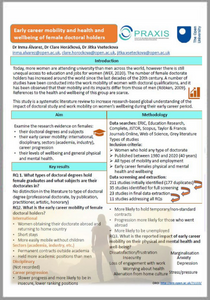
Early career mobility and health and wellbeing of female doctoral holders
Early career mobility and health and wellbeing of female doctoral holders
Dr Inma Álvarez, Dr Clare Horáčková, Dr Jitka Vseteckova
Introduction
Today, more women are attending university than men across the world, however there is still unequal access to education and jobs for women (WEF, 2020). The number of female doctorate holders has increased around the world since the last decades of the 20th century. A number of studies have been conducted into the work mobility of women with doctoral qualifications, and it has been observed that their mobility and its impacts differ from those of men (Röbken, 2009). References to the health and wellbeing of this group are scarce.
This study is a systematic literature review to increase research-based global understanding of the impact of doctoral study and work mobility on women’s wellbeing during their early career period.
Aim
Examine the research evidence on females:
- their doctoral degrees and subjects
- their early career mobility: international, disciplinary, sectors (academia, industry), career progression
- their levels of wellbeing and general physical and mental health.
Methodology
Data searches: ERIC, Education Research, Complete, JSTOR, Scopus, Taylor & Francis Journals Online, Web of Science, Grey literature
Types of studies
Inclusion criteria:
Women who hold any type of doctorate
- Published between 1980 and 2020 (40 years)
- All types of mobility and employment
- Early career females physical and mental health and wellbeing
Data screening and extraction:
211 studies initially identified (177 duplicates)
35 studies identified for full screening
23 studies in final data extraction
11 studies addressing all RQs
Key results
RQ 1. What types of doctoral degrees hold female graduates and what subjects are their doctorates in?
No distinction in the literature to type of doctoral degree (professional doctorate, by publication, practitioner, artistic, honorary)
RQ2. What is the early career mobility of female doctoral holders?
International
- Women obtaining their doctorate abroad and returning to home country
- Short stays
- More easily mobile without children
Sectors (academia, industry, etc.)
- Permanent contracts outside academia
- Held more academic positions than men
Disciplinary
(Not recorded)
Career progression
- Slower progress and more likely to be in insecure, lower ranking positions
- More likely to hold temporary/non-standard contracts
- Progression more likely for those who went abroad
- More likely to be unemployed
RQ3. What is the reported impact of early career mobility on their physical and mental health and well-being?
Dissatisfaction/frustration
InsecurityAnxiety
Loss of engagement with work Depression
Worrying about health
Alienation from home culture
Marginalisation
Stress/pressure
ORO: http://oro.open.ac.uk/71133/
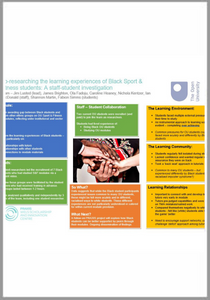
Co-researching the learning experiences of Black Sport & Fitness students: A staff-student investigation
Co-researching the learning experiences of Black Sport & Fitness students: A staff-student investigation
Team – Jim Lusted (lead), James Brighton, Ola Fadoju, Caroline Heaney, Nichola Kentzer, Ian MacDonald (staff), Shannon Martin, Fabion Simms (students)
Rationale
The is an awarding gap between Black students and those from other ethnic groups on OU Sport & Fitness (S&F) modules, reflecting wider institutional and sector trends.
Aims
To explore the learning experiences of Black students – focusing particularly on:
- relationships with tutors
- relationships with other students
- Connections to module materials
Methods
The student researchers led the recruitment of 7 Black OU students who had studied S&F modules via a recruitment video. Two online focus groups were facilitated by the student researchers who had received training in advance. Focus groups lasted between 1-2 hours. Data was analysed qualitatively and independently by 3 members of the team, including one student researcher.
Staff – Student Collaboration Two current OU students were recruited (and paid) to join the team as researchers. Students had lived experience of:
- Being Black OU students
- Studying OU modules
So What?
Data suggests that while the Black student participants experienced issues common to many OU students, these might be felt more acutely and in different, racialised ways to white students. These different experiences are not particularly understood or catered for within current module provision.
What Next?
A follow-on PRAXIS project will explore how Black students can be better supported by peers through their modules. Ongoing dissemination of findings.
The Learning Environment:
- Students faced multiple external pressures on their time to study
- An instrumental approach to learning was evident – completing over achieving
- Common pressures for OU students could be faced more acutely and differently by Black students
The Learning Community:
- Students regularly felt isolated during studies
- Lacked confidence and wanted regular re-assurance they were on track
- Took a ‘back seat’ approach in tutorials
- Common to many OU students – but experienced differently by Black students (e.g. racialised imposter syndrome?)
Learning Relationships
- Important to connect with and develop trust with tutors very early in module
- Tutors pre-judged capabilities and were harder on TMA mistakes/rushed work
- Compared themselves negatively to white students - felt like (white) students able to ‘play the game’ better
- Need to encourage support networks; continue to challenge ‘deficit’ approach among tutors

Exploration of the knowledge and skills of WELS associate lecturers in relation to supporting students with a mental health difficulty
Exploration of the knowledge and skills of WELS associate lecturers in relation to supporting students with a mental health difficulty
Joan Simons, Annette Duensing, Kate Breeze, Sarah Vicary, Faculty of Wellbeing, Education and Language Studies (WELS)
Our aim was to investigate with WELS associate lecturers (ALs) their skills and experience of dealing with students who have mental health diffiulty and to explore what support they need to be confident in their ability to support or signpost students with a mental health diffiulty.
In relation to training in mental health ALs reported having informal updates on mental health issues, but no formal training at the OU. There was a range of responses in relation to how well equipped they felt in relation to supporting students with a mental health issue, and a large majority of ALs reported that they would welcome more training, with suggestions as to what that should be.
Findings
Most of the 39 ALs who were interviewed had tutored at the OU for many years and had noticed a steady rise in the number of students with a mental health difficulty. Anxiety followed by depression were the most frequently experienced mental health difficulty.
Many ALs felt it necessary to maintain boundaries with students who had a mental health difficulty.
The following are skills suggested by ALs as necessary to support students with a mental health difficulty: Counselling skills, coaching skills, communication skills, listening skills, interpersonal skills, to be attuned/intuitive/able to recognise early warning skills and to the ways students are communicating with us, to know when to have difficult conversations, to have the ability to be realistic and honest to know one’s limitations.
Conclusion
ALs are experienced in supporting the growing number of students with a mental health difficulty but feel the need on training on the issue so that they can feel more confident in the support they provide for students.
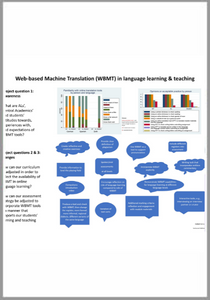
Web-based Machine Translation (WBMT) in language learning & teaching
Web-based Machine Translation (WBMT) in language learning & teaching
Karina von Lindeiner-Strasky
Project question 1: Awareness
What are ALs’, Central Academics’ and students’ attitudes towards, experiences with, and expectations of WBMT tools?
Project questions 2 & 3:
Changes
How can our curriculum be adjusted in order to reflect the availability of WBMT in online language learning?
How can our assessment strategy be adjusted to incorporate WBMT tools in a manner that supports our students’ learning and teaching.
- Create reflective and creative exercises
- Provide information to level the playing field
- Compulsory introduction video
- Produce a text and check with WBMT, then change the register, more formal, more informal, regional dialects, different variants of the same language
- Provide clear definition of plagiarism
- Spoken/oral assessments at all levels
- Encourage reflection on role of language learning compared to role of WBMT
- Variation of text sorts
- Use WBMT as a tool to support pronunciation
- Incorporate WBMT explicitly
- Demonstrate WBMT capabilities for language learning at different language levels
- Additional marking criteria: reflection and engagement with module materials
- Include different registers into assessment
- Writing task that incorporates written commentary
- Interactive tasks, e.g., interviewing an interview partner or a tutor
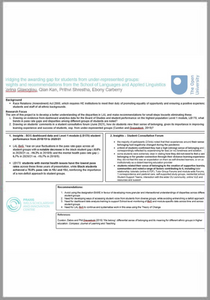
Bridging the awarding gap for students from under-represented groups: Insights and recommendations from the School of Languages and Applied Linguistics
Bridging the awarding gap for students from under-represented groups: Insights and recommendations from the School of Languages and Applied Linguistics
Korina Giaxoglou, Qian Kan, Prithvi Shrestha, Ebony Carberry
Background
Race Relations (Amendment) Act 2000, which requires HE institutions to meet their duty of promoting equality of opportunity and ensuring a positive experience of students and staff of all ethnic backgrounds.
Research Focus
The aim of this project is to develop a better understanding of the disparities in LAL and make recommendations for small steps towards eliminating these.
Drawing on evidence from dashboard analytics data for the Board of Studies and student performance on the highest population Level 1 module, LB170, what trends in pass rate gaps and disparities among different groups of students are noted?
Drawing on students’ comments in a student consultative forum (June 2021), how do students view their sense of belonging, given its importance in improving the learning experience and success of students, esp. from under-represented groups (Cureton and Gravestock, 2019)?
Insights - BOS dashboard data and Level 1 module (LB170) student performance from 2018/19 to 2020/21
- LAL BoS: Year on year fluctuations in the pass rate gaps across all student groups with a notable decrease in the black student gap (-8.8% in 2020/21 vs. -14.3% in 2018/9) and the mental health pass rate gap (-6.7% in 2020/21 vs. -15.7% in 2018/9).
- LB170: students with mental health issues have the lowest pass rates across these three years of presentation, while Black students achieved a 78.8% pass rate in 18J and 19J, reinforcing the importance of a non-deficit approach to student groups.
Insights – Student Consultative Forum
- the majority of participants (2/3rds) noted that their experiences around their sense of belonging had negatively changed during the pandemic
- a third of students confirmed they had a high (strong) sense of belonging and was correspondingly reflected by experiencing far less (or no) loneliness and isolation
- some students were extremely clear in stating how they did not need to feel a sense of belonging or for greater connection through their distance learning experiences - they did not feel this was an expectation on them as self-directed learners, or on us institutionally as a distant learning education provider
- students related their sense of belonging to the creation of supportive learning communities and noted a range of factors contributing to it, including tutor relationship, tutorials (online & F2F), Tutor Group Forums and module wide Forums, 1-2-1 correspondence and pastoral care, self-supported study groups, residential schools, Student Support Teams, interaction with the wider OU community, online VLE and resources and support
Recommendations
- Avoid using the designation BAME in favour of developing more granular and intersectional understandings of disparities across different student groups
- Need for developing ways of accessing student voice from students from diverse groups, while avoiding entrenching a deficit approach
- Need for dashboard data analysis training to support School-level monitoring of BoS and module-specific data across time and across student groups
- Need for LAL BoS to continue and systematise work in this area using the Theory of Change
References
Cureton, Debra and Phil Gravestock (2019) ‘We belong’: differential sense of belonging and its meaning for different ethnic groups in higher education. Compass: Journal of Learning and Teaching.
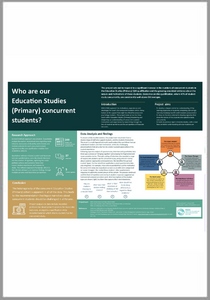
Who are our Education Studies Primary concurrent students?
Who are our Education Studies Primary concurrent students?
Lore Gallastegi – Senior Lecturer, ECYS
This project sets out to respond to a significant increase in the numbers of concurrent students in the Education Studies (Primary) Q94 qualification and the growing anecdotal evidence about the nature and motivations of these students. Outcomes on this qualification, where 47% of students study concurrently, are consistently well above OU averages.
Introduction
Wild (2018) explored the motivations, experiences and challenges for Level 1 OU concurrent students. Penny looked at the support that might be offered to concurrent psychology students. This project looks across the three levels within Education Studies (Primary) broadening and deepening our understanding of concurrent students’ motivations and experiences by researching through the lens of student narratives and the perspectives of Associate Lecturers.
Projects Aims
- To develop a deeper and richer understanding of the learning experience of students completing Q94 at high intensity (studying two 60-credit modules concurrently)
- To draw on the data collected to develop vignettes that share the stories of the students who opted to study concurrently
- To build on previous Open University studies, with a clear focus on better understanding who our students are
Research Approach
A mixed methods approach was adopted. Quantitative analysis focussed on anonymised data regarding study intensity, declaration of disability and ethnicity and module outcome for each concurrent student registered on the core qualification modules from 2018/19 to 2020/21.
Qualitative methods included student and Associate Lecturer questionnaires, semi-structured interviews and the creation of vignettes, exploring the social, political, cultural and economic forces that impact student experiences and reasons for study. This reflexive approach (Flyvbjergb 2013) to the rich data allowed us to read our findings through multiple personal and theoretical perspectives.
Key project statistics
- 249 Student and associate lecturer questionnaires
- 37 interviews
- 5 student vignettes
Data Analysis and findings
To ensure a fully rounded analysis the project team was drawn from a diverse range of staff who support students, and the students themselves. The result is a multi-layered and multi-vocal analysis that can inform how we understand students and their motivations, while also challenging preconceptions that act as barriers to a more nuanced appreciation of the student experience.
Following separate analysis of questionnaire, interview and quantitative data there was a process of “bringing together” and weaving the fragmented and more complete stories. Thematic coding of interview data revealed a range of reasons why students opt for concurrent study, along with rich stories about students’ approaches and experiences. We identified five general student ‘types’. Further detail from qualitative student questionnaire data was integrated. For example, those who responded that a prime motivation for concurrent study was to graduate as soon as possible were categorised as “career changers”. We tracked these students’ other questionnaire responses to add to the overall picture of this cohort. This process continued until the level of repetition and overlap in student responses suggested we had reached a natural saturation point. Brief descriptions of the student types are shown in a form that captures their interrelatedness.
- The coper-adapter: “I considered deferring one module, but it would just slow things down. To cope, I have had to skip different bits of content”.
- The career changer: “I’ve already had ten years’ experience in another career, so studying one module at a time would be a long career change. Concurrent study is challenging, but I see it as a season of sacrifice”.
- The intentional full-timer: “I thought about going to a brick university, but there were lots of reasons why that wouldn’t have worked for me.“
- The multi-tasker: “I am systematic and organize my time, socially, academically, and professionally along the lines of a ‘tight ship’. I always aim to get everything done early so that if anything pops up then I’m covered.”
- The sophisticated learner: “I think the most important thing to remember is that studying with the OU is about independent study – that’s what you’re signing up for.”
Key project questions
- Why are students choosing to study full time?
- What was their decision making process?
- What is their experience of studying at full time intensity?
- What should the OU be doing differently in regard to those students?
Conclusion
The heterogeneity of the concurrent Education Studies (Primary) cohort is apparent in all of the data. This leads to the recommendation that legacy narratives about concurrent students should be challenged in all forums. Project outputs to date include recorded professional development sessions for Associate Lecturers, alongside a qualification-wide recorded tutorial which shares student tips for concurrent study.
Project team
E103: Carolyn Cook, Clare Tope, Mandy Reddin
E209: Claire Saunders, Roisin McPhilemy, Paula Addison-Pettit, Jill Delsoldato
E309: Lore Gallastegi, Fiona Henry, Lorraine Moore
References
Cooke et al. (2021) Who are our Education Studies (Primary) concurrent students? Open University Scholarship Exchange
Flyvbjerg, B. (2013) ‘Case Study’. In Denzin, N.K., and Lincoln, Y.S. (Eds.) Strategies for Qualitative Research, Sage, London.
Penny, R. (no date) Developing support for students studying at high intensity’ (OU report).
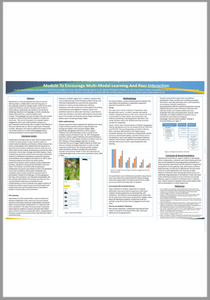
An Evaluation Of The Use Of Openstudio Adapted For A First Level Foundation Module To Encourage Multi-modal Learning And Peer Interaction
An Evaluation Of The Use Of Openstudio Adapted For A First Level Foundation Module To Encourage Multi-modal Learning And Peer Interaction
Lucy Rai, Nashwa Ismail, Sally Ogut, Tajinder Gill, Evelyn Mooney, Kerry Jones, Ceinwen Gwilym, Michelle Carrington, Joanna Rawles
Abstract
OpenStudio is a tool developed by the Open University which provides a collaborative online learning space. It was originally created as a design studio, similar to the social media tool Pinterest, and has only been used to date in STEM subjects. OpenStudio was piloted in the Faculty of Wellbeing, Education and Languages on K102, Introducing Health and Social Care, a new foundation level module. This pedagogic tool was included in the new module to explore its value at this level for students in health and social care. The aim of this project is to evaluate student engagement with multi-modal activities and peer-to-peer interaction and learning. Also, to explore how effective is the use of OpenStudio as a tool to support peer interaction on K102. Moreover, the research explores the impact of the use of Open Studio as a multi-modal pedagogic tool to develop participation and conceptual thinking on K102.
Literature review
Collaborative learning or peer to peer communication within modules has been shown to have a positive impact on student retention (Rienties and Toetenel, 2016). However, the extent of participation with collaborative learning varies as does the level of student satisfaction with its use (Cross et al 2015). Open Studio created, developed and used by The Open University in the context of design and STEM modules. These modules have primarily used the tool to provide a method for students to collaborate and prepare assessments based on visual artefacts such as diagrams (Creswell et al. 2017). Open University evidence has shown that while student performance improves when modules include collaborative activities, satisfaction rates generally fall (Open University 2016). This finding is consistent with the piloting of collaborative assessment was piloted on K101 and withdrawn in part due to problems with student satisfaction and complaints about equity arising from unequal levels of participation. Despite the challenges of encouraging peer learning, communication is an important employability skill (for example; NMC 2019). This has been the driver for the current research which aims to evaluate the use of OpenStudio as a tool to motivate and support students to develop foundation steps into peer learning through multi-modal using a low-risk tool which draws on interactions familiar in social media, such as Pinterest.
Peer learning
OpenStudio on K102 module offers a way for students to develop collaboration skills, which are one of the twelve elements of the Open University Employability Framework (Open University 2018). Collaboration is an important skill and is identified in The Open University Levels Framework which requires students to connect and work with others’ which at level 1 involves working with others, recognising and following accepted conventions of learning interaction (Open University 2015).
Nelwati et al (2018) suggest that ‘In addition, cognitive skills such as deep learning, critical thinking, problem solving, and reflective thinking skills are essential to be acquired by students in order to provide professional, effective, therapeutic, and safe nursing care to their patients by making clinical decisions and judgement. However, there is less published research on online peer learning in social work or social care education, and where addressed this has primarily been in the context of virtual placements (Taylor and Salmon 2020) or peer mentoring (Crooper 2000).
Multi-modal learning
Literacy researchers have recognized the significance of visual modes of literacy and how they can expand options for writing and reading in the classroom (Siegel, 2006). Specifically, photographs have been used to support reflection and critical thinking as well as connect to the multiple contexts of children’s lives.’ (p. 537). Photographs have been used to support reflection and critical thinking as well as connect to the multiple contexts of children’s lives.’ (p. 537). Taking a critical pedagogy approach, his study found that the use of images helped students to reflect and share on complex everyday experiences in order to make connections with theory. The study found that ‘students made connections between everyday life and abstract concepts and enhanced ‘depth’ in their learning where we understand depth to be a sense of connectedness’ (Sakr, 2020 p. 868).
Methodology
The study employs a mixed methods approach between the quantitative and qualitative is explanatory-sequential approach (Creswell et al, 2017).
Survey
The study starts with the collection of quantitative data, through online survey, in order to measure and analyse students’ engagement and use of the tool to measure the level of participation on Open Studio and correlate this with retention, performance and engagement with tuition. The survey has been sent to 167 students and 144 out of this number has responded.
Figure 1 below shows the percentage of students’ engagement with the OpenStudio tool over the module for K102, KXY102 and KYN102. The overall attendance on K102 in 20J was 53%, a rise from 18% on K101 in 19J. There is only a correlation between the introduction of OpenStudio and this increase in tutorial participation, and other factors such as the pandemic, may in part explain this change in behavior. However, this increase is significant and very positive as an indicator that the tool may be supporting greater peer learning.
The quantitative cycle is followed by qualitative deep dive to learn more about the context behind the figures through online focus group with 6 associate lecturers and in-depth one-to-one online interviews with 14 students.
Focus group with associate lecturers
Tutors reflected on students’ experience in using OS differently; some were with this experience referring to students’ positive experience in promoting their self-confidence, self-reflection and developing work-based skills. On the other hand, other tutors narrated their negative views about OS referring to students’ limited time to do the activities using OS and their lack of engagement with each other.
One-to-one students’ interviews
Peer-to-peer interaction, collaborative learning and their impact on students’ learning and their skills, have been addressed as emerging themes.
Students narrated this impact from two different perspectives: firstly; socially such as, feeling connected with others. Secondly, personally such as self-confidence and creativity. Students related these two perspectives with the academic perspectives and highlighted how peer-to-peer interaction influences their learning. Finally, some students addressed some challenges they have confronted when using OS. These challenges are related to different variances such as limited time and limited technological knowledge. Summary about students’ findings is illustrated below, see- figure 3.
Conclusion & Recommendations
OpenStudio has benefits to support students in developing skills in collaboration, reflection and critical thinking skills and also has the potential to encourage greater participation in tuition generally. OpenStudio has the potential to support the development of core graduate skills, particularly in practice-based learning. To maximise its effectiveness the tool needs to be set up with appropriate sizes of groups to allow effective moderation whilst also giving students access to a sufficiently large population of contributors. Tutors also need to be sufficiently prepared to ensure that they can provide effective support to students to facilitate them in using the tool. Further research is needed to test out the impact of the tool on participation in tuition longer term.
References
Cross, S. Whitelock, D. & Healing, G. (2015) Collaborative Learning and Assessment (CoLAb) Project: Final Report Institute of Educational Technology. The Open University
Creswell, J. W. and Plano Clark, Vicki L. (2017) Designing and conducting mixed methods research. 3rd edition.; International student edition
Cropper, A. (2000) ‘Mentoring as an inclusive device for the excluded: Black students' experience of a mentoring scheme’, Social work education, 19(6), pp. 597–607. doi:10.1080/02615470020002326.
Nelwati, Abdullah and Chan (2018) ‘A systematic review of qualitative studies exploring peer learning experiences of undergraduate nursing students’ in Nurse Education Today, volume 71, p185-192
Open University (2016) Collaborative online activities - a guide to good practice , online
Rienties, B. and Toetenel, L. (2016). The impact of 151 learning designs on student satisfaction and performance: social learning (analytics) matters. In: Proceedings of the Sixth International Conference on Learning Analytics & Knowledge – LAK
Sakr, . (2020) ‘'It just opened my eyes a bit more': student engagement with Instagram to develop understanding of complex concepts’, Teaching in higher education, 25(7), pp. 858–871. doi: 10.1080/13562517.2019.1613356.
Siegel, M. ( 2006) ‘Rereading the Signs: Multimodal Transformations in the Field of Literacy Education’, Language Arts 84(1): 65-77.
Taylor, L. and Salmon, G. (2021) ‘Enhancing Peer Learning through Online Placements for Health and Social Care Professions’, International journal of practice-based learning in health and social care, 9(2), pp. 1–10. doi:10.18552/ijpblhsc.v9i2.723.
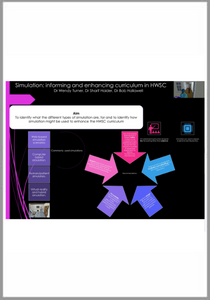
Simulation: informing and enhancing curriculum in HWSC
Simulation: informing and enhancing curriculum in HWSC
Dr Wendy Turner, Dr Sharif Haider, Dr Bob Hallawell
Aim
To identify what the different types of simulation are, for and to identify how simulation might be used to enhance the HWSC curriculum
Commonly used simulations
- Web-based simulation scenarios
- Computer based simulation.
- Human/patient simulators.
- Virtual reality and hybrid simulation.
Recommendations
- Use of simulated learning that is based online, unlikely to be scalable should additional costs / equipment be required (outside of expected equipment i.e. laptop, headphones, microphone).
- Skilled and knowledgeable facilitation and debriefing is a key aspect of simulated education.
- Need to design in simulated education as part of content – planned via the student journey / planner
- Accessibility : student needs to be enabled to make adjustments (to the simulation) ie speed of speech / visual
- Student (and tutor) control of the activity important for repetition, practice, revision to promote active learning.
- Simulated learning should be designed into the learning rather than added on.
- Simulation was used to prepare students for real-life practice

Teaching Spanish Pronunciation
Teaching Spanish Pronunciation
Zsuzsanna Bárkányi, Lecturer in Spanish, School of Languages and Applied Linguistics
Introduction
the ultimate goal of foreign language learning is mostly speaking.
Pronunciation is important
- self-esteem
- active during other language skills
Lack of pronunciation teaching
- automatically acquired [4]
- lack of teacher training [3]
- lack of teacher confidence [2]
- myth of having to sound native [1]
Benefits of explicit pronunciation teaching proven [4, 5]
Course: Teaching Spanish pronunciation
OpenLearn Create then OpenLearn: 15k visits
Content
- Why teach pronunciation?
- The building blocks of pronunciation
- Stress, rhythm and intonation
- Spanish and English vowels contrasted
- Spanish and English consonants contrasted
Critical evaluation (three trained Spanish teachers)
- well-structured, clear and convincing
- explains complex phonological topics in an
Accessible way
- allows for better informed pronunciation activities
Ways to go
- more audio files for illustration
- more ideas for exercises
- refer to other languages as well as an increasing
Number of OU students are non-native speakers
- put more emphasis on the variety of accents
- more pronunciation teaching methods
- more pronunciation error correcting techniques
Workshop
Most participants think:
- pronunciation should be taught
- explicit instruction is effective
- students learn pronunciation unconsciously
Teaching techniques in our modules
- automatic repetition and imitation
- ear-training
- phonetic instruction
- raising phonological awareness
- real-time interactive activities with
- focus on pronunciation
Perceived barriers
- student anxiety
- lack of personal contact due to GTS
- lack of training in pronunciation error correction
- choice of target language model
Recommendations
Teaching pronunciation is beneficial
- detailed pronunciation syllabus
- create a module specific pronunciation
Correction checklist
- targeted listening tasks (e.g. phoneme
- identification, connected speech phenomena, varieties)
- contrasting target language and other familiar languages
Strategies to cope with anxiety related to speaking and pronunciation is helpful.
References
- Derwing, T. M., & Munro, M. J. (2009). “Putting accent in its place: Rethinking obstacles to communication.” Language Teaching 42, 476–490. https://doi.org/10.1017/S02614448080055
- Henderson, A. et. al. (2012). “The English Pronunciation Teaching in Europe Survey: Selected Results. Research in Language 10 (1). Doi:10.2478/v/10015-011-0047-4
- Kirkova-Naskova, A. (2019). Anastazija Kirkova-Naskova: Second language pronunciation: a summary of teaching.
- Rao, R. (Ed.). (2019). Key Issues in the Teaching of Spanish Pronunciation. London: Routledge, https://doi.org/10.4324/9781315666839
- Thomson, R. I., & Derwing, T. M. (2015). “The effectiveness of L2 pronunciation instruction: A narrative review.” Applied Linguistics, 36(3),26–344. https://doi.org/10.1093/applin/amu076
Please see also our past project posters.
![]()
